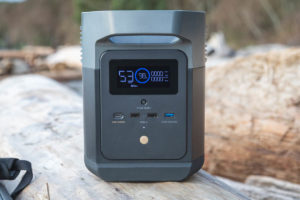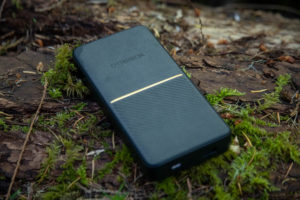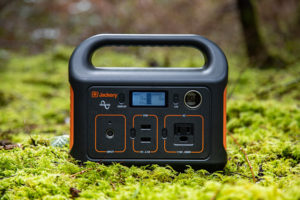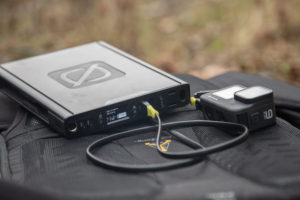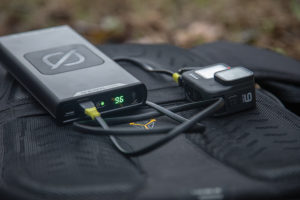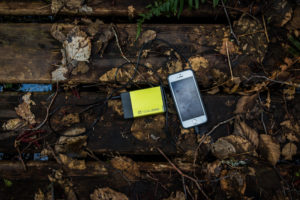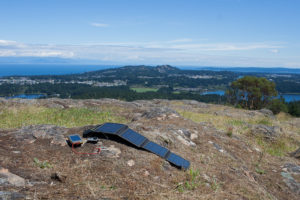Everything has a battery these days. And if you run out of battery then you’re device is useless. Your phone GPS app can’t tell you wear you are. Your camera can’t take any photos. Your drone is just a rock in your backpack.
Portable power is a broad range of different sized batteries that have USB outlets, and sometimes AC outlets, to charge all your devices. Small devices usually just have 1 USB port and can charge a phone once. Large power stations have multiple USB-A, USB-C and AC outlets and can charge phones, laptops, portable fridges or TVs.
What exactly you need depends on what you want to charge and for how long. Bigger devices will require bigger batteries to charge them. Check out the reviews and buying guide below for info on our favourite battery packs and power stations.
Battery pack and power station reviews
- EcoFlow Delta Mini Portable Power Station ReviewIt’s tough to on a road trip, camping or working around the house without extra electricity. All our devices depend… Read More »EcoFlow Delta Mini Portable Power Station Review
- Otterbox 20,000 mAh Fast Charge Power BankMaker of indestructible phone cases, Otterbox now makes super-tough, portable 10k, 15k and 20k mAh battery banks.
- Jackery Explorer 240 Review: Portable Power Station
The Jackery Explorer 240 Power Station can power laptops, tvs, fans and lights but is still lightweight and easy to carry around.
- Goal Zero Sherpa 100AC Battery Pack Review
25600 mAh of power to charge up laptops, cameras, drones and just about anything else you have on your remote trips.
- Goal Zero Sherpa 100PD Battery Pack ReviewDevices are taking over our lives. It’s a double edged sword with so many cool gadgets and gizmos helping us… Read More »Goal Zero Sherpa 100PD Battery Pack Review
- Tiny Power: The GoalZero Flip 30 ReviewGoalZero started in 2009 out of Robert Workmans work abroad to reduce poverty. He was frustrated with all the obstacles… Read More »Tiny Power: The GoalZero Flip 30 Review
- SunJack 14W Solar Panel and 8000mAh BatteryWhat happens when the batteries in your gadgets die right in the middle of an adventure? You’ll probably just toss… Read More »SunJack 14W Solar Panel and 8000mAh Battery
Tips for Buying a Battery Pack or Power Station
Battery packs are small, power stations are large
Battery packs and power stations both charge things. Battery packs are small and usually charge your phone 1 to 3 times. Power stations are much larger, charging your phone dozens of times, or powering household appliances like TVs, fans or heaters.
Power stations are much larger and heavier. Power stations are popular for camping, road trips, van life and overloading. They are also very useful for emergency situations at home. Battery packs can fit in your pocket or pack and are lightweight and packable, but only offer a phone charge or 2.
What is mAh and wH?
Battery packs and power stations are measured in their capacity. Just like backpacks and water bottles are measured by the number of litres they can hold, batteries are measured by the amount of electricity they can hold. Small batteries often hold 3000 to 10,000 mAh or milliamp-hours. They can charge a phone a couple times.
Every battery, like the one on your phone, will hav a capacity on it as well. This is the amount of electricity needed to fully charge your phone from empty when it’s off. When it’s on it will use electricity to run as you charge it. An iPhone 12 has a battery capacity of 2,815 mAh so you’ll need a battery with at least 2,815 mAh to fill it up. To charge it twice you’d need at least 5630 mAh (2815 x 2).
Watt-hours or wH are kind of like litres to millilitres, just a larger form of measurement. There’s a bit of calculation involved because it depends on the voltage as well. For example a GoalZero 100PD battery has 94 watt-hours of capacity. When converted to a milliamp-hour equivalent, that’s about 25600 mAh. A good number of phone charges anyways.
What is USB-C?
USB-C is the new USB connector that is replacing the flat rectangular USB plug we see on everything now. USB-C is a smaller rounded plug that is capable of handling higher power and faster charging. USB-C is reversible can can be plugged in either direction.
What is PD or Power Delivery?
Power Delivery is a special kind of the USB-C port that can deliver faster charging. If the USB-C port is Power Delivery capable then it can charge up to 60 watts on a regular cable and up to 100 watts on a special cable, that’s fast enough to power large laptops. Many laptops, tablets, and cameras are coming with PD ports. Some larger battery packs and power stations are as well.
An important measurement to keep in mind with a PD port is the wattage and each are different. A MacBook Pro uses 85 watts to charge off it’s native charger. It can use a 60 watts to charge just at a slower rate. And using an 18 watt would only charge the Pro if it’s asleep.
How many watts and volts do I need?
Every battery and power station will have different the power ports. The best thing you can do is to find the wattage and voltage of the best supported charger for your device, then try to get a battery or power station that supports that.
If you need to charge something with 60 watts with Power Delivery make sure there is a port that supports that on the battery. Sometimes battery packs that are rated for 60 watts across all their ports. You might need this output on a single port.
Comments
If you have a question about battery packs or power stations, leave a comment below!
